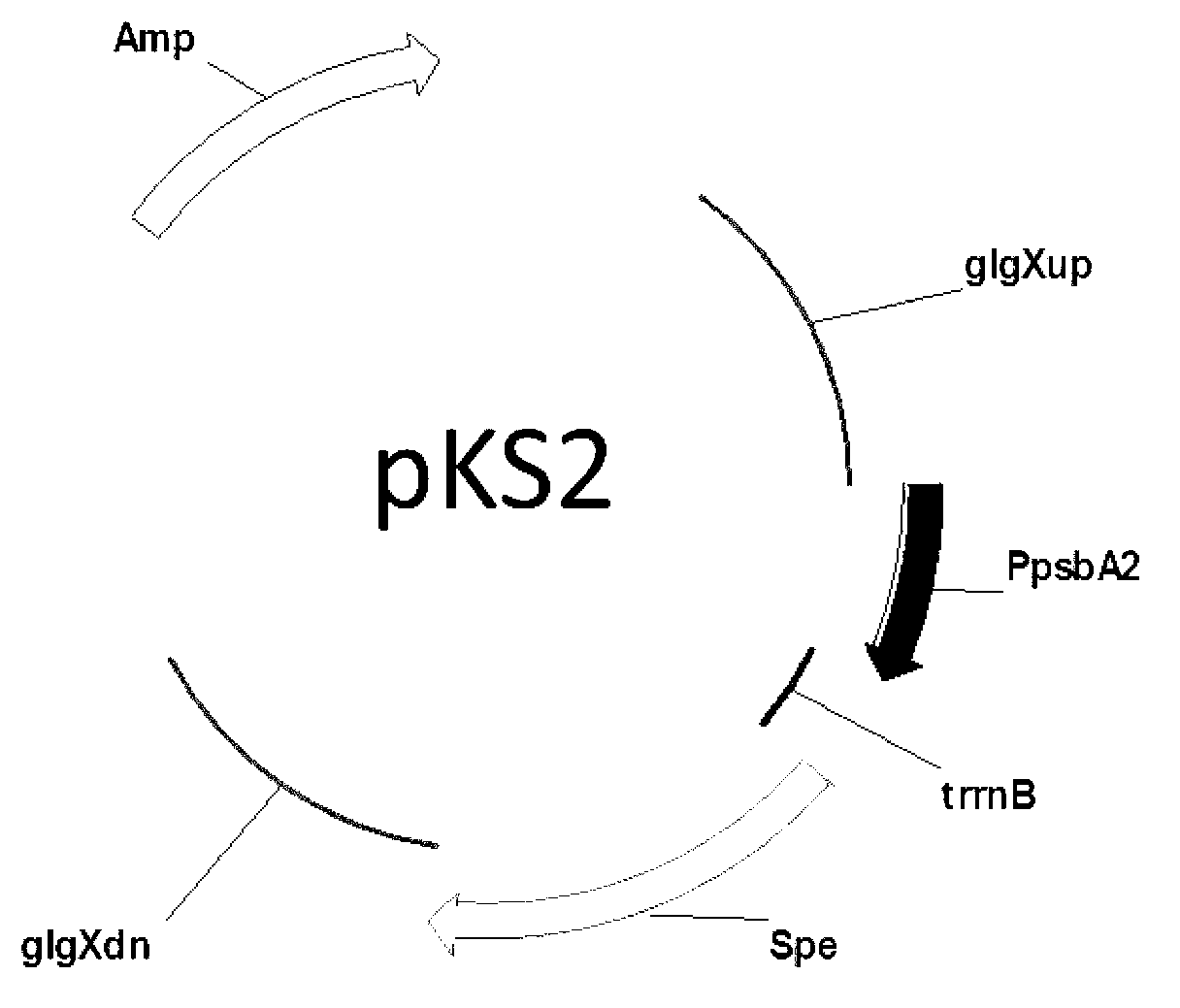Method for producing isoprene by utilizing blue algae
A technology of isoprene and isoprenyl pyrophosphate, applied in the field of genetic engineering, can solve the problems of low yield and high cost, and achieve the effects of increasing yield, expanding application scope and widening industrial application prospects
- Summary
- Abstract
- Description
- Claims
- Application Information
AI Technical Summary
Problems solved by technology
Method used
Image
Examples
Embodiment 1
[0076] Example 1 1. Construction of expression vector integrating Synechocystis genome
[0077] 1.1. Construction of plasmid pKS2
[0078] Plasmid pKS2 is a homologous recombination vector inserted at glgX (slr0237) site in Synechocystis sp. PCC6803 genome. Using the Synechocystis sp. PCC6803 genome as a template, the primer pair P5 and P6 amplified the upstream homology arm glgX-up sequence (glgXup), and the primer pair P7 and P8 amplified the downstream homology arm psbA2-down sequence (glgXdn), and loaded in sequence into the pBluescript KS+ plasmid, and then introduce the spectinomycin marker (Spe), and at the same time introduce the endogenous promoter of Synechocystis PCC6803 encoding psbA2 (P psbA2 ) and the trrnB terminator sequence (trrnB) of Escherichia coli to obtain the homologous recombination vector pKS2 (SEQ ID NO: 47) expressing the target gene, the plasmid schematic diagram is as follows figure 2 shown.
[0079] 1.2. Construction of plasmid pKS3
[0080...
Embodiment 2
[0083] Example 2 , codon optimization
[0084] The isoprene synthase encoding gene e1ispS derived from Eucalyptus globulus, the original DNA sequence is from the GenBank database (GenBank: AB266390.1), and the sequence is shown in SEQ ID NO:50. The isoprene synthase coding gene p1ispS derived from poplar (Populus alba), the original DNA sequence is from GenBank database (GeneBank: AB198180), and the sequence is shown in SEQ ID NO: 51. The isoprene synthase p2ispS derived from Populus alba x Populus tremula, the original sequence is from the GenBank database (GenBank: AJ294819.1), and the sequence is shown in SEQ ID NO: 52. Among them, none of the e1ispS, p1ispS and p2ispS sequences contain a signal peptide, and p2fulllength (SEQ ID NO: 53) is a full-length sequence containing a signal peptide. The above DNA sequence was synthesized by Nanjing GenScript Company.
[0085] By using the GeneDesigner software of DNA2.0 Company, according to the codon preference of Synechocystis...
Embodiment 3
[0091] Example 3 , promoter screening
[0092] Using the Synechocystis sp. PCC6803 genome as a template, the following promoters were cloned: the primer pair P37 and P38 cloned the promoter P of psbA psbA 2 (SEQ ID NO: 57), primer pair P41 and P42 clone rbc operon promoter P rbc (SEQ ID NO: 58), primer pair P43 and P44 clone groESL operon promoter P groESL (SEQ ID NO:59), primer pair P45 and P46 clone Ni 2+ inducible promoter P nrsB (SEQ ID NO: 60), primer pair P47 and P48 clone ftsQ operon promoter P ftsQ (SEQ ID NO: 61). Using the plasmid pTrcHis (purchased from Invitrogen) as a template, the primer pair P49 and P50 were used to clone the promoter P trc (SEQ ID NO: 62).
[0093] The above-mentioned promoters are used to replace the pP in Example 2 respectively cpc The P amplified by the primer pair P39 and P40 in the k1*ispS plasmid cpc Promoter (SEQ ID NO: 63), resulting in plasmids expressing k1*ispS using different promoters. The above plasmids were respectivel...
PUM
 Login to View More
Login to View More Abstract
Description
Claims
Application Information
 Login to View More
Login to View More - R&D
- Intellectual Property
- Life Sciences
- Materials
- Tech Scout
- Unparalleled Data Quality
- Higher Quality Content
- 60% Fewer Hallucinations
Browse by: Latest US Patents, China's latest patents, Technical Efficacy Thesaurus, Application Domain, Technology Topic, Popular Technical Reports.
© 2025 PatSnap. All rights reserved.Legal|Privacy policy|Modern Slavery Act Transparency Statement|Sitemap|About US| Contact US: help@patsnap.com



